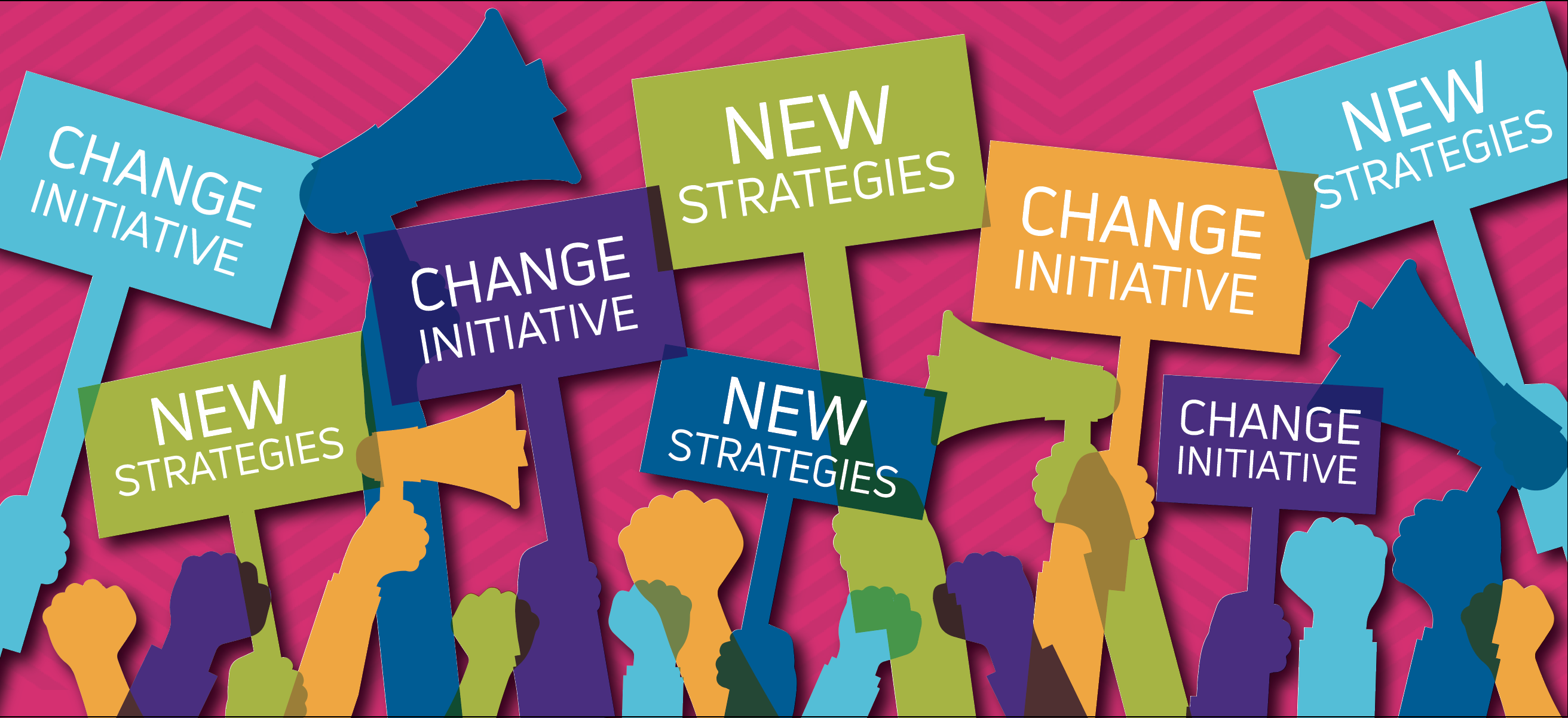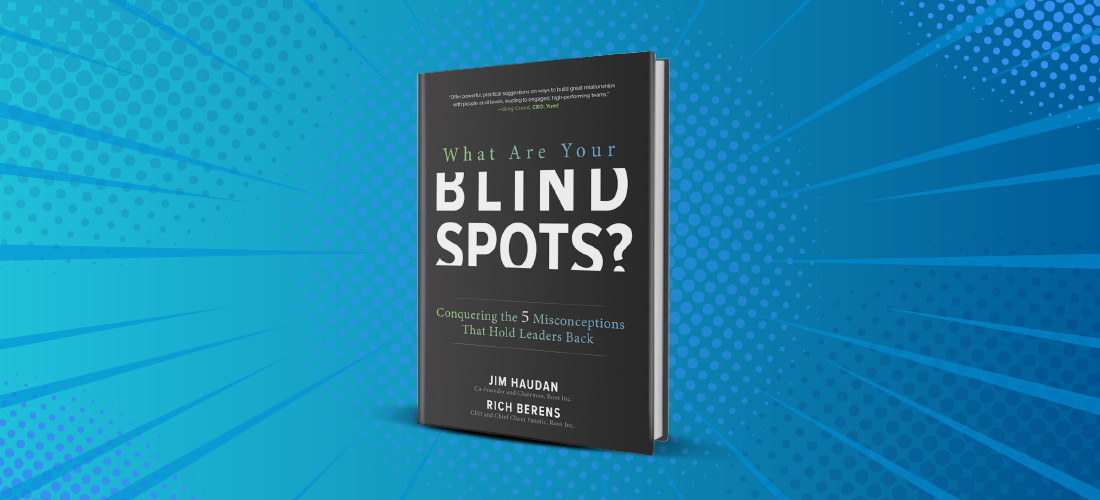
Jim Haudan
Chairman and Co-Founder
As Chairman and Co-Founder, Jim Haudan has a passion that goes beyond leading Root to success. For more than 25 years, he has been helping the world’s most influential organizations transform their business, change how they engage their people, and deliver exceptional results.
Jim captures Root’s story in his bestselling book, “The Art of Engagement: Bridging the Gap Between People and Possibilities” (McGraw-Hill, 2008). His latest book, “What Are Your Blind Spots? Conquering the 5 Misconceptions that Hold Leaders Back” (McGraw-Hill, 2018) – co-authored by Root CEO and President, Rich Berens – dives into the effective ways to engage and motivate employees at every level of the organization.
Jim is a frequent speaker on leadership alignment, strategy execution, employee engagement, business transformation, change management, and accelerated learning. He has spoken at TEDx BGSU, Tampa TEDx, and Conference Board events, and has given keynote speeches for many organizations throughout the world. He contributes regularly to business publications, including Inc. and Switch & Shift, where he was ranked on the Top 75 List of Human Business Champions.
He lives in Sylvania, OH, with his wife, Michelle. They have three children, Brad, Brooke, and Blake, and five grandchildren. When he’s not traveling the globe visiting clients, he enjoys relaxing with his family at their lake cottage, golfing, fishing, sailing, photography, and attending Jimmy Buffett concerts.
Posts By Jim Haudan

It’s Time to Stop Measuring the Engagement of Our People 2.0
It’s time to do the right thing, not to try to manufacture the right measures or put employees to the test. Doing the right thing starts with leaders asking questions and measuring their own actions.
Inside the Art of Thinking Together
How do we create conversations that can change our teams, organizations, and even the world? How can we create meeting spaces people look forward to being in? How do we make our meetings safe spaces for honest conversations? Here are some of the tenets of the art of thinking together.
The Missing Process That Makes All the Difference: Strategy Activation Through People
As you prepare to activate your strategy, remember who helps bring it to life: YOUR PEOPLE. Here are eight steps to help bring your plans to reality together.
The Role of Risk Alignment in Great Team Decision-Making
More is lost by indecision than by making the wrong decision. Yes, the wrong decision is better than indecision.
Sharing Your Stories Builds High-Performing Teams
The elevation to high performance took a major leap by understanding and appreciating each other’s stories.
The Thirteen Key Behaviors of High-Performance Teams
When a senior team makes behavioral ground rules or behavioral expectations like this for the team as a whole and for each member individually, they’ll be well on their way to high performance
Rediscovering the Soul of Your Business and Your People
Eight lessons to ensure you're invigorating the power of human beings to make a difference.
The Accountability Myth
Do you hold people accountable or do you CREATE accountability? The difference is important and could change the way your people feel about work.
Leadership Lessons from the Flea Circus
Job crafting is a powerful tool and can help employees find long-term enjoyment at work. Is job crafting a priority at your organization?
Quotes from Three Decades of Taking Notes on Strategy Activation and Human Change
The lessons learned through others can be extremely impactful on your journey. Here are some quotes to inspire you at work and beyond.
The Three Critical Leadership Tips of 2022
People are reassessing how they spend their time. If leaders want to keep valuable employees, they need to become active players in the Great Reassessment.
Assumptions Impact Success: The Power of Positive Intent to Build Trust
Assuming positive intent is the single behavior that high-performance teams choose time and again. How’s your intent meter reading?
Leaders Need to Give Power Back to Their People
What if people need to stop waiting to receive what they want and instead start changing their own experience, with or without permission?
Simple Actions and a Deep Curiosity Make the Greatest Impact
Today leaders must do more to create a place that reenergizes people & enables them to contribute their best. Here are two key questions to ask.
Is Your Organization Skilled in the Art of Dialogue? 6 Tips for Communication Success.
Dialogue is at the root of all effective engagement and group action. Here are six tips to help ensure that dialogue thrives at your organization.
Workforce Evolution and the Employee Experience
Employees are resigning from their jobs at rates we’ve never seen before, making it clear that they’re the ones with the power. Leaders and organizations must adapt to meet the needs of today’s workers.
Five Ways to Create Genuine Connections that Matter
According to a Harvard study, 85 percent of professional success comes from people skills. Here are five tips to help you find more success!
The Antidote to the Great Resignation
Great leaders know how to actively listen and empower rather than direct and tell. It's the best way to unlock the power of human capital.
Three Do’s and Don’ts for Your Post-Covid-19 Workplace
We can't return to the “old” ways of working or leading. Here are three do's and dont's for a post-Covid workplace.
Q&A: Leaders Share Insights on DEI, Mental Health, and the Future of the Workplace
Jim Haudan discusses diversity, equity, and inclusion (DEI), and mental health with six C-suite leaders.
Three Engaging Questions to Transform Your Team to High Performance
High-performance teams are the result of people committing to build something together that is special. Here are tips to make this happen at your organization.
Three Ways Leaders Can Create Connections in 2021 and Beyond
Creating highly connected and bonded teams is different now. Three habits leaders can adopt to create connections and help people feel valued.
Advice from Leaders Who Found Success in 2020
Working from home can be isolating. To help with this challenge, successful leaders weigh in on how to create cohesive and engaged workplaces.
Turning Next-Level Leaders and Front-Line Teams into Change Advocates
For an organization to conceptualize and roll out transformative change, it needs every single employee on board. Click for tips.
Leaders Need to Change Too
Strategy without execution is meaningless and execution without senior team engagement is impossible. Leaders set the tone and must change first.
Saying Thanks by Giving Back
The concept of “giving back” is showing up outside the expected.It appears to be a critical ingredient in sustaining meaningful human behavior change.
Engaging People in Duress Versus Engaging People in Success to Achieve Strategic Change
Did you know that people don’t resist change? It's true. They resist being told to change or being changed by someone else. This is an important distinction and one that leaders must take to heart.
6 Reasons Why Servant Leadership is Best
A servant leader's goal is to bring the best out of others and help them work at a higher level. Here are six reasons why servant leadership really works.
3 Key Tips to Engage Your Employees in the Big Picture
People must understand how a business operates and what it takes to win if they give their best efforts. Three tips to encourage everyone to work together.
10 STRATEGY QUESTIONS SMART LEADERS ASK THEMSELVES EVERY DAY
Strategy without execution is meaningless, and execution without engagement is impossible. Is your company actually executing your strategy through people.
Discomfort Is the Precursor to Breakthrough
Believe it or not, along with discomfort comes opportunity – because we are forced to think in a new way and push ourselves to find a solution we didn’t see initially. And that’s the path to a breakthrough.
The Send Button Is Stuck and the Receive Button Is Broken
Collaboration is powerful. You just have to be wiling to loosen your grip on being right. You need to enter a conversation ready to receive others’ ideas and then layer your thoughts on top of them. By approaching a conversation this way, you’ll wind up with solutions you never thought of before.
How Do You Build Trust During a Crisis?
If your people don’t trust your leadership, then navigating a crisis and delivering future success become nearly impossible.
Leading Through a Crisis: Part II
Jim Haudan speaks with Dr. Rick Lofgren, president and CEO of UC Health, and Charlie Piscitello, chief people officer at Acutus Medical, Inc. to get their thoughts as how leaders can best lead during challenging times.
Leading People Through a Crisis
Recently, Root Inc. co-founder Jim Haudan met via video conference with Jim Boomgard, president and chief executive officer of DAI: International Development, and Joe Morgan, seasoned CEO, advisor and strategist, to get their insights on leadership during the Covid-19 crisis.
Leading Your People in Times of Crisis
The big differentiator is how leaders empathize, engage, motivate, and capitalize on their talents and knowledge in the face of adversity.
Hug the Thunderstorm
While welcoming adversity might feel counterintuitive and against how most human brains are wired, the benefits are huge. So the next time you’re facing what you would normally consider an undesirable and unexpected problem, try hugging that thunderstorm of adversity. Odds are, you’re about to see your personal growth skyrocket.
A Q&A on Employee Engagement
Is employee engagement a buzzword? What leaders can do to foster an engaged workforce.
Lessons Learned from a College Football Team that Wanted to Change
Not long ago, several of us at Root got a chance to work with a Division I college football team to help reestablish a high-performance culture and team.
The Art of Co-Thinking: Three Steps to Making Great Decisions (without taking a vote)
Decision-making within an organization can be a sticky subject. Emotion and opinion are at play, which can cloud facts and impede forward motion to the end result. Here are some tips to help you achieve collaborative decision-making.
Eight Steps to Becoming a Master Decision Maker
There is a decision-making process that blends the need to make fact-based decisions with the urgency to act, while tapping the immense knowledge
Breaking Old Patterns: Why Co-Think Is the Best Way to Approach Engagement
PowerPoint effectively showcases data, but it might not be an effective engagement tool or the best way to get people to care about what you're sharing.The Time is Now: Creating a Meaningful Purpose
While there are many buzzwords clouding the business world, one that is making a lot of noise at the current time is Purpose.
The Power of Dialogue: Engagement Is About Conversations, Not Presentations
The times when we need to be the most conscious of others are when things get chaotic, stress levels run high, and deadlines loom. But, this rarely happens.The One Trait for Success that Overshadows All Others
There are many different ideas about the characteristics a person must possess or develop to become successful. At the top of many people's lists are
7 Ways to Foster a Culture of Engagement
There is nothing better than working in an organization that has a great culture. According to Deloitte, 94% of executives and 88% of employees believeWhen Was the Last Time You Were Truly Listened To?
Think about the last time you were at dinner with a group of friends and you witnessed two people trying to talk through a tough issue. How did it go?
Engaging People to Execute: Think of it as a Process
In sports or business, winning isn’t automatic just because you buy, recruit, or develop great talent. Performance and execution are as much tied to
10 Strategy Questions Smart Leaders Ask Themselves Every Day
Strategy without execution is meaningless. Execution without engagement is impossible. What strategy questions are you asking yourself and other leaders?
Want to be a Better Leader? Identify Your Blind Spots.
Leaders owe it to their people to eradiate the blind spots that are most certainly holding back their people, their business, and their cumulative success.
5 Leadership Blind Spots That Perpetuate Disengagement & Indifference
Jim Haudan, and Rich Berens of Root Inc. detail 5 leadership blind spots that hinder employee engagement and innovation in the workplace.
Dialogue at Work is the Oxygen of Engagement and Change!
The lack of real dialogue is preventing change in organizations. Here are six ways to ensure dialogue thrives in your organization.
Great Leadership Secrets From Michelangelo and Picasso
Here are three ways to use visualization to drive the a-ha moment and excitement around an idea in your organization today.
How One Company Grew Revenue $16M in 6 Months
Little changes can have a big impact on the bottom line. When a company focuses on simple adjustments they can see huge results.
How the Worst Leaders Destroy Trust in the Workplace
When leaders assume their people have positive intent, the impact on the company culture can be dramatic and greatly improved.
3 Things Smart People Do to Create Meaningful Lives
It's important to create meaningful lives so here are three things smart people do to create meaningful lives for themselves.
Successful Strategy Execution Is All about Behaviors
The purpose of strategic planning is not to make plans. It’s to change the way we think and act. If our newly formed visions and strategic plans
Bridging the Gap
It has been more than 20 years since we first drew “The Canyon,” and yet it still evokes animated responses, chuckles, and reflections from anyone
5 Steps for Engaging Employees through Challenging Times or Corporate Change
Dealing with problems head-on and recognizing that your people can be critical resources to helping overcome difficult situations is key.
Leaders Aren’t Telling the Stories Their People Care About
Rich Berens, our company President and Chief Client Fanatic, announced he and I are writing a book on our belief that work is broken.
Time to Get Vulnerable: Why The Best Leaders View Vulnerability as a Strength
Howard Shultz, CEO of Starbucks, once said, “The hardest thing about being a leader is demonstrating or showing vulnerability
EQ Is Giving IQ a Run for Its Money: Why Being Emotionally Intelligent May Be More Important Than Being Smart
Emotional Intelligence, or EQ (Emotional Quotient) as it is commonly called, emerged as a hot topic back in the mid-1980s. Yet, today EQ is more relevant
No Risk, No Culture Reward
Risk taking leads to ideas and breakthroughs that can drive new business. In fact, the only way to be successful is to fail forward on purpose.
Personal Purpose in the Workplace
We sat down with two Root executives this month – Founder and CEO Jim Haudan and Consultant (and millennial) Kara Davidson – to discuss personal purpose
Peer Accountability – A Powerful Performance Driver
Many organizations attempt to create a climate of accountability with robust performance management systems. The hope is that by building
Invasion of Fears
Realism and truth telling are at the heart of authentic engagement. However, many organizations lack this realism. And the higher you go the more rare
The FUSS About Bright Spots
What keeps leaders up at night? Things like figuring out how to tweak a business model; how to do things faster, better, and cheaper;
What Business Can Learn from Sports (Hint: It Has Nothing to Do With Sports)
College Basketball. UCLA. Ten NCAA National Championship titles in 12 years, seven of those consecutively. Coach: John Robert Wooden.
Embracing Paradox
Paradox is important because new strategies get stuck in translation around a major paradox causing polarization instead of creating a platform for change
Team Insight Is Just As Valuable As Consumer Insights
To truly understand how business is won and how successful work gets done is what helps an organization make the right “on” the business decisionsNot Succumbing to the “Other Guy” Syndrome
The voice of fear and limitation can easily change your growth mindset from being intensely focused on being better, to being consumed with being bitter.
Changing Behaviors or Forming a New Habit Is Hard
Driving change is one of the hardest things to do. Approaching it as you would to form a new habit helps make it manageable and achievable.
It’s Time for the “Third” Documentary
At a time where creativity and strategic innovation is falling short and change is a way of life, people are not showing up at work engaged in what they do.
Structure Change Doesn’t Solve the Problems
Leaders commonly when the business isn’t performing - “we must have the wrong people or management team in place” – and they initiate a structure change.
Building a High-Performance Operations Team
For an organization to be successful, it needs a high-performance operations team. Learn how to build one today.
What Do Student Debt and Strategy Execution Have in Common?
What does student debt have to do with strategy execution? It is all about elevating your thinking and seeing the big picture as an interconnected system.
High Noon in Yesterday Town: Is This YOUR Business?
If you think constant change is some-thing new, step back in time with me to the days of the Old West. Let’s see what happened in Yesterday Town
Owning the Whole Before Your Piece – Part 1
The real key is each team member must own the whole before their piece: They must sacrifice the area they represent for the overall good of the company.
Lifecycle of Strategic Change
Engaging the entire company in the strategic change enables people to understand how they fit and how they can best enact the change that is needed.Your Managers Aren’t Aligned on Your Strategy
No matter how great your strategy, it can come to a grinding halt if your managers can’t interpret and translate that strategy
Lessons from Grandma – Growing and Giving
the essence of her golden touch was that she figured out long ago that giving and growing were inseparable. You couldn’t have one without the other.
Roots of Engagement Issue Four – People want to Know their Contributions Make an Impact
Link people who test, build, manufacture, pilot, serve, and transport the products and services to how it impacts the people using them.
Roots of Engagement Issue Three – People Want to Go on a Meaningful Journey
A meaningful journey has challenge, risks, excitement, suspense, unexpected events, unknowns and a purpose that makes it all worthwhile
Roots of Engagement Issue Two – People Want to Feel a Sense of Belonging
Building a sense of belonging to the team of the future for your people is an important proactive art of leadership and engagement.
Roots of Engagement Issue One – Being Part of Something Bigger Than Yourself
The perennial advice to college grads is “find yourself.” Root CEO Jim Haudan (and others) suggest the real point is to “lose yourself.”
Great Management: It’s More Than Just a Promotion
Engagement hinges on creating a clear line of sight from the marketplace to every employee so they can execute strategy. In working with clients
Gain Loyalty by Sharpening Customer Service
If you’ve been focusing on operational excellence or innovative product development, maybe it’s time to take a look at your company’s ideas
Technology: Are We Using It, or Is It Using Us?
Yogi Berra once said, “You can observe a lot just by watching.” On a plane last week, the second we touched down, I observed most people around me
Onboarding-the People Who Belong to Your Future
“Onboarding” is a term used on cruise ships, but most companies don’t operate on boats. And starting a new position or understanding your role
Employee Engagement: Being Part of Something Bigger than Yourself
A few years ago New York Times writer David Brooks wrote an article during the graduation season that really struck a chord with me.
Employees as Customers: Discovering What’s Relevant
For the first time in history, companies are experiencing four generations of people working side by side, where the age difference may be 50 years or more
Changing Mindsets in Turbulent Times
Some companies emerge from an economic downturn stronger and more highly valued than they were before the economy soured.
The Manager’s Role in the Whack A Mole Game
Management can be like playing whack-a-mole – the old kids’ game where you try to pound down whichever mole pops up through the holeMore deeply rooted thinking

Unlocking Your Potential
Leadership essentials are sneaky. They seem basic, but they are the very things we need to revisit – like LeBron, the pianist, and the senior leader – to reach the untapped potential we have lying inside us.

It’s Time to Stop Measuring the Engagement of Our People 2.0
It’s time to do the right thing, not to try to manufacture the right measures or put employees to the test. Doing the right thing starts with leaders asking questions and measuring their own actions.

The Strategy Activation Leader
The world’s best strategy activation leader intuitively lives by these beliefs and knows they’re no longer measured by their individual brilliance but by their ability to serve others by shifting mindsets and building capabilities across the enterprise.








